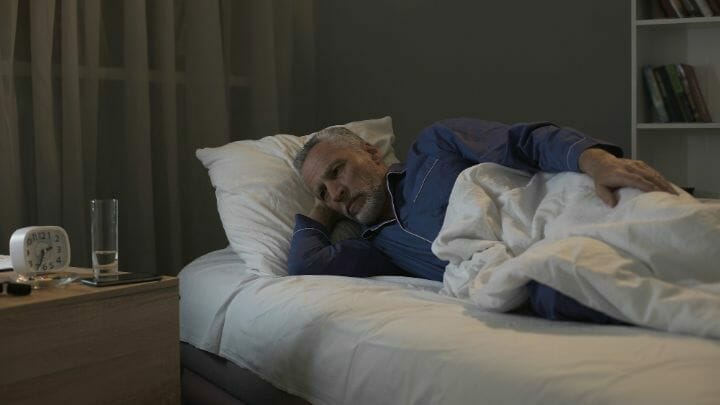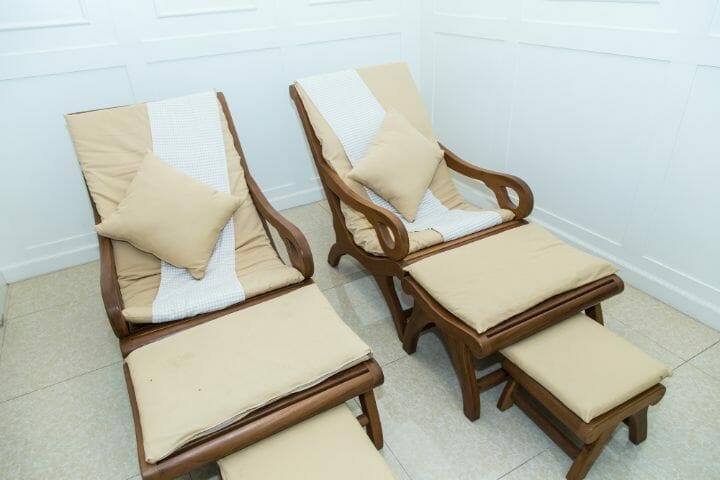Having trouble falling asleep after your knee replacement surgery? You are not alone.
The extreme exhaustion of undergoing this major surgery, accompanied by pain and anxiety, form the perfect combination to keep anyone sleepless throughout the night.
Add to it an inappropriate sleeping position, and you get a dangerous cocktail of insomnia accompanied by knee damage.
The best sleeping position after knee replacement surgery, as advised by physicians, is to sleep on your back. While sleeping on your side or a recliner is acceptable, one needs to follow some strict guidelines to avoid stress on the knees.
A complete no-no during this recovery phase is sleeping on your stomach.
There are a couple of things that we suggest you should know while lying down to sleep as you might need to rest a lot for a few weeks after the surgery.
This article is your complete guide to all the sleeping troubles after knee surgery, different sleeping positions to help you sleep comfortably, some cautionary words, and tips at the end that you must know.
Contents
What Can Disturb Your Night Sleep Post-Surgery?
- The answer to this can be found in the study – A sleep disturbance after total knee arthroplasty – that confirms that after a knee replacement surgery, nearly 50% of the patients have disturbed night sleep due to nocturnal knee pain (pain at night)
- Anxiety and stress can also lead to sleep deprivation and vice-versa.
- The pain medications which you are on can also affect the quality of your sleep.
- Concerns about recovery and fear of damaging the knee while sleeping may also keep you awake at night.
However, all the above concerns and fears can be done away with by learning about the different sleeping positions post-surgery and how they may help or harm your knee.
Best Sleeping Positions
The following are the ideal sleeping positions after a knee replacement procedure.
Sleeping on Your Back
The best position to sleep or lie down after surgery is to lie straight on the back. Keep the legs straight so that there is no obstruction of blood flow to the knee and to the drainage of lymph fluid (responsible for swelling in the knees) back from the knee. Do not place the legs one over the other.
Keep a pillow under the knee, not directly under it but longitudinally below the leg under the calf area. Raise the leg above the level of the heart. It will ensure the fluid collected in the knee area drains back with the help of gravity to the lymph nodes in the groin area.
It will decrease the swelling of the knee and hence the pain and discomfort associated with it. If one pillow is too thin, consider adding another one to raise the height.
There is no rule against keeping a pillow under the feet, but doing so will only add unnecessary strain on the knee and lead to pain. So avoid placing it directly under the feet.
One can also consider using a wedge pillow to elevate the leg. A wedge pillow has memory foam or polyfoam. The more common ones are triangular. The other kind has a straight plateau-like part to rest the lower leg and is triangular where it goes under the thigh up to the knee.
These pillows give a better elevation and stay in place much better than the conventional pillows without slipping away.
As the wound heals and the swelling decreases, the need for elevation will reduce, especially at night. While you may need to keep elevating your leg 3-4 times a day, your physician might advise you otherwise at night.
You may also like Best Age for Knee Replacement Surgery
Sleeping on a Recliner
Many people, who are uncomfortable sleeping on their back, actually find sleeping on a reclining armchair or easy chair more comfortable. Though it is more of a seated position, one can consider it for sleeping at night, along with elevating their leg.
Sleeping on the Side
If you are accustomed to sleeping on the side and feel uncomfortable lying down straight, you can lie down sideways but with a pillow in between your legs. However, be cautious not to sleep on the operated leg but the other one.
If you have had a knee replacement of both the legs together, avoid sleeping sideways initially, immediately after the surgery, and sleep only on your back, at least till the knee has healed.
Placing a pillow between the legs when sleeping sideways provides cushioning to the legs and avoids direct impact between the knees.
You may also like Preparing for Knee Replacement Surgery
A Word of Caution About:
1. Sleeping on Your Stomach
DO NOT sleep on your stomach after knee replacement surgery, even though you might be used to sleeping in this position. Lying down on your stomach can put a lot of pressure on the operated knee.
The wound may leak fluid, and the bed might rub against it. It would also cause a lot of pain.
2. Sleeping During the Day
As for night sleeping, follow similar precautions and measures while sleeping during the day, like keeping the legs elevated. One can also catch up on their sleep while icing during the day.
Just be cautious not to keep the ice on the knee for too long and use an alarm or a timer to avoid the same.
You may also like Pros and Cons of Partial Knee Replacement
3. Sleeping in Different Positions
Until about a week after surgery, it is advised to sleep on your back. As the pain and swelling decrease, you may be allowed to sleep sideways, even though only for short periods.
Sleeping on the stomach is still not allowed. After the staples are removed from the knee (3 weeks and after), sleeping on the side will be more comfortable and painless.
Now that you have understood all about sleeping positions, here are a few tips for improving your sleep quality.
You may also like Yoga After Knee Replacement
Few Tips to Ensure a Good Night’s Sleep
Pre-sleeping rituals are just as important as sleep itself. Here are a few things you can build into your daily nighttime schedule.
1. Ensure a firm mattress that can hold the body in a straight position without sinking in.
2. Keep all your essentials like your phone, water required for the night within your reach.
3. Follow R.I.C.E. – Rest, Ice, Compress, Elevate
Rest – Although exercise is essential postoperatively, rest is equally important to allow the body to carry on the healing process.
Ice – Icing the knee with some ice pack has to be done at least five times a day with two-hourly gaps in between. Ice the area even before sleeping to reduce swelling and hence pain and discomfort. Elevate the knee higher than the hip so that on icing, the fluid from the knee flows back to drain into the lymph nodes in the groin area. Avoid any kinds of heat treatments till at least 6-8 weeks after surgery.
Compress – Any compression therapy, such as compression socks, is to be done only after consulting the medical practitioner and only in the initial days of post-surgical healing.
Elevate – When sitting, elevate legs using some knee pillow under the lower leg. When sleeping, elevate the bed from the foot end or elevate the leg by keeping some pillows longitudinally, under the calf muscles, to raise the height of the knee above the heart level for fluid drainage.
4. Take your pain medication just before sleep to give at least a few hours of pain-free sleep.
5. Take a lightweight comfortable duvet on top.
6. Avoid bright lights in the room. If needed, use a night lamp.
7. Try putting on some soothing music at low volume or keep a mild aromatic lamp by the bedside.
8. Counter sleep aids, such as Melatonin, can be used after consulting your specialist.
After going through a knee replacement surgery, the last thing a patient needs is the consequent problem of being unable to fall asleep or remaining uncomfortable throughout the night while trying to sleep.
The above pointers should help put your mind at ease about the correct sleeping positions, avoiding damage to your knees, promoting timely healing, all this while giving you a fulfilling night’s sleep.




